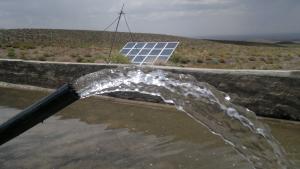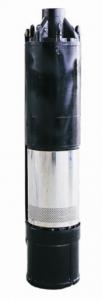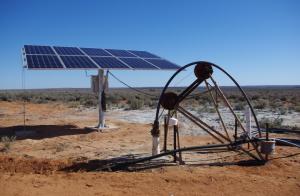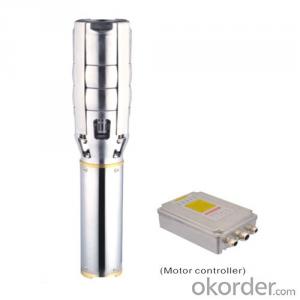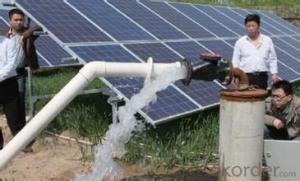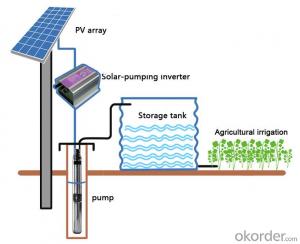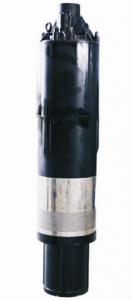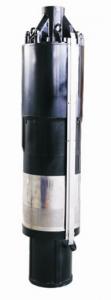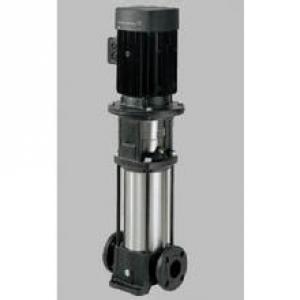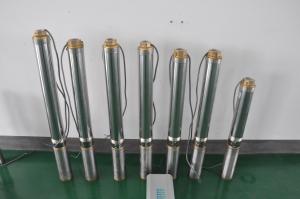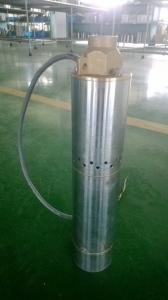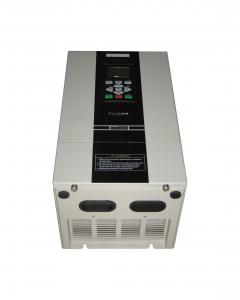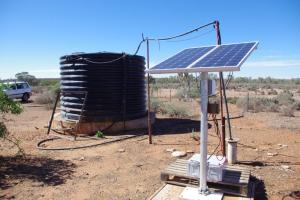1 Hp Solar Pump 3ds-4
- Loading Port:
- China Main Port
- Payment Terms:
- TT OR LC
- Min Order Qty:
- -
- Supply Capability:
- 300 sets set/month
OKorder Service Pledge
OKorder Financial Service
You Might Also Like
Product description:
Product: Solar water pump
Model:3DS-4
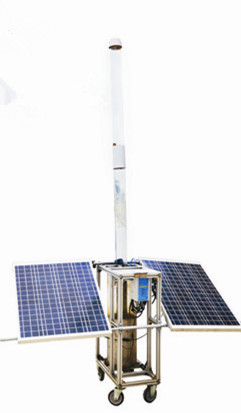
Appilication:
submersible pump
for deep well near a house
for drinking water of one family (3-4 people)
for watering a small garden
Product specification:
flow rate:300 liter/ hour, 2m3/day.
lift: 10m-100m
pump diameter: 94mm
well diameter more than 102mm
with BLDC motor, motor power:360W
but only need solar power:100W, our pump can save more than 50% solar panel power.
Material:
Pump inside: stainless steel and wearable nylon,it enables our solar pump to have 10 years sevice life.
Motor length:20cm,70% shorter than other motors. So that you can pump 70% more water by our solar pump.
Certification:
3 International patent
ISO9001
CE
Warranty:2 years
- Q: Can a solar pump be used for landscape watering?
- Yes, a solar pump can be used for landscape watering. Solar pumps are designed to harness energy from the sun and convert it into power to pump water. This makes them an eco-friendly and cost-effective option for landscape watering. Solar pumps are capable of drawing water from various sources such as ponds, wells, or rainwater harvesting systems, and distributing it to the desired areas in your landscape. They can be used for both small-scale residential gardens or large-scale commercial landscapes. With the advancements in solar technology, solar pumps have become increasingly efficient and reliable, providing a sustainable solution for landscape watering while reducing the dependence on traditional electricity sources.
- Q: Can a solar pump be used for fountain installations?
- Indeed, fountain installations can utilize solar pumps. These pumps are specially designed to operate efficiently and harness solar power, rendering them an eco-friendly alternative for fountains. Their functioning involves the conversion of sunlight into electricity, which in turn propels the pump to circulate water within the fountain. Installing solar pumps tends to be straightforward, and they necessitate minimal upkeep. Furthermore, these pumps are suitable for both small and large fountain installations. Moreover, they do not mandate a direct electrical connection, thereby eliminating the need for wiring or reliance on grid electricity. On the whole, utilizing a solar pump presents an excellent opportunity to power fountain installations with renewable energy.
- Q: How often does a solar pump need maintenance?
- A solar pump typically requires minimal maintenance and can operate efficiently for several years without any major issues. Regular maintenance checks, such as cleaning the solar panels and inspecting the pump for any blockages or leaks, should be performed every 6-12 months to ensure optimal performance and longevity.
- Q: Can a solar pump be used for water supply in mining or construction sites?
- Yes, a solar pump can be used for water supply in mining or construction sites. Solar pumps are ideal for these applications as they can provide a reliable and sustainable water source without the need for electricity or fuel. They can operate remotely in areas with limited access to power grids and are capable of pumping water from deep wells or rivers to meet the water demands of mining or construction activities. Additionally, solar pumps are cost-effective and have low maintenance requirements, making them a practical choice for these sites.
- Q: How much energy does a solar pump consume?
- A solar pump consumes very minimal energy as it relies on solar panels to generate power from sunlight, making it an energy-efficient and environmentally friendly option.
- Q: How does the performance of a solar pump vary with different water quality parameters (e.g., turbidity, pH)?
- The performance of a solar pump can be influenced by various water quality parameters such as turbidity and pH. Turbidity refers to the cloudiness or haziness of the water caused by suspended particles such as sediment, silt, or organic matter. High turbidity levels can negatively impact the performance of a solar pump. It can reduce the amount of sunlight reaching the solar panels, thereby reducing the efficiency of the pump. Additionally, suspended particles in turbid water can cause abrasion and damage to the pump components, leading to decreased performance and potential breakdowns. Therefore, it is important to ensure that the water source for a solar pump has low turbidity levels to optimize its performance. pH is a measure of the acidity or alkalinity of water. The performance of a solar pump can also be affected by the pH level of the water it is pumping. Extreme pH levels, either too acidic or too alkaline, can cause corrosion or scaling inside the pump system. Corrosion can damage the pump components, leading to decreased efficiency and potential failure. Scaling refers to the deposition of minerals or other substances on the pump surfaces, which can reduce the flow rate and increase energy consumption. Therefore, maintaining an optimal pH level within the recommended range is crucial for ensuring the longevity and efficiency of a solar pump. In summary, both turbidity and pH can significantly impact the performance of a solar pump. High turbidity levels can reduce sunlight exposure and cause mechanical damage, while extreme pH levels can lead to corrosion and scaling issues. Therefore, it is important to consider and manage these water quality parameters to maximize the efficiency and lifespan of a solar pump.
- Q: Can a solar pump be used in residential rainwater harvesting systems?
- Yes, a solar pump can be used in residential rainwater harvesting systems. Solar pumps are an energy-efficient and sustainable option for pumping water, making them a suitable choice for residential rainwater harvesting systems that aim to collect and store rainwater for various uses such as irrigation, toilet flushing, and laundry. By harnessing the power of the sun, solar pumps can operate without the need for electricity from the grid, reducing energy costs and environmental impact.
- Q: How does a solar pump compare to a diesel-powered pump?
- Solar pumps and diesel-powered pumps differ significantly in terms of their advantages and disadvantages. When it comes to cost, a solar pump necessitates the installation of solar panels and batteries, resulting in a higher initial expense. Conversely, a diesel-powered pump has a lower upfront cost but incurs ongoing fuel and maintenance costs. In the long run, a solar pump can prove more cost-effective due to its reliance on renewable energy sources and absence of continuous fuel purchases. In regard to environmental impact, a solar pump is highly eco-friendly as it utilizes clean solar energy and emits no pollutants. It contributes to the reduction of carbon footprint, air pollution, and dependence on fossil fuels. In contrast, a diesel-powered pump emits harmful greenhouse gases and pollutants, thus exacerbating air pollution and global warming. When it comes to reliability, a solar pump may be less dependable in areas with inconsistent sunlight or during cloudy days. However, technological advancements have enhanced solar pumps, making them more efficient and capable of storing excess energy for use during low-light periods. On the other hand, a diesel-powered pump is highly reliable as long as there is a continuous fuel supply. Maintenance and operational costs also differ between the two pump types. Solar pumps generally require less maintenance due to their fewer moving parts compared to diesel-powered pumps. However, if repairs or replacements are needed, solar components can be more expensive due to their specialized nature. Diesel-powered pumps require regular maintenance, such as oil changes and filter replacements, along with ongoing fuel costs. Lastly, solar pumps are particularly suitable for remote areas or places lacking access to electricity grids, as they operate independently using solar energy. In contrast, diesel-powered pumps necessitate a constant fuel supply, which can be challenging or costly in remote locations. Ultimately, the selection between a solar pump and a diesel-powered pump hinges on factors such as upfront costs, environmental considerations, reliability, maintenance requirements, and the availability of electricity or fuel. Each option possesses its own advantages and limitations, and the decision should be based on the specific needs and constraints of the situation.
- Q: How does a solar pump handle power fluctuations or surges?
- A solar pump typically handles power fluctuations or surges by having built-in protection mechanisms. These mechanisms can include voltage regulators, surge protectors, and inverters that convert DC power from the solar panels into stable AC power for the pump. This helps ensure that the pump receives a consistent and reliable power supply, even when there are fluctuations or surges in the solar power output.
- Q: Are there any environmental benefits to using a solar pump?
- Yes, there are several environmental benefits to using a solar pump. Firstly, solar pumps rely on renewable energy sources, such as sunlight, to generate power, which significantly reduces dependence on fossil fuels and decreases greenhouse gas emissions. Additionally, solar pumps do not require fuel or electricity from the grid, reducing the overall carbon footprint. Moreover, solar pumps have minimal noise pollution and do not contribute to air or water pollution, making them environmentally-friendly alternatives to traditional pumps.
Send your message to us
1 Hp Solar Pump 3ds-4
- Loading Port:
- China Main Port
- Payment Terms:
- TT OR LC
- Min Order Qty:
- -
- Supply Capability:
- 300 sets set/month
OKorder Service Pledge
OKorder Financial Service
Similar products
Hot products
Hot Searches
Related keywords



